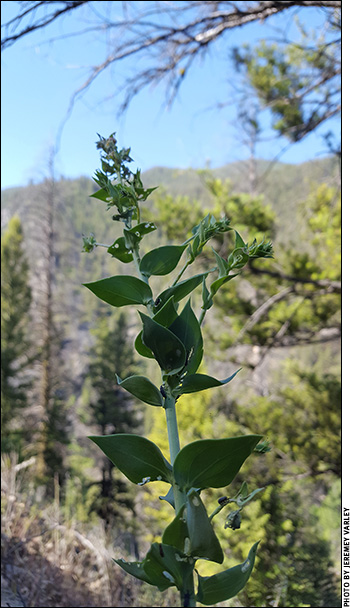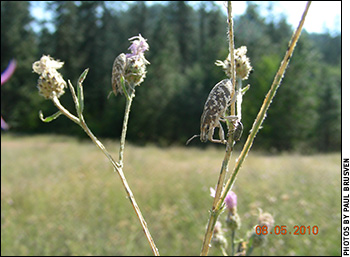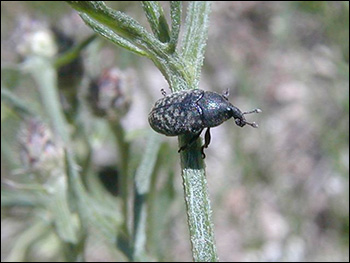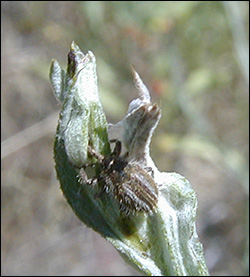Biological Control of Invasive Weeds
Ranchers and rangeland managers who are trying to find ways to halt prolific spread of invasive weeds can use biologic controls.

The stem-weevil (Mecinus janthinus) attacks dalmation toadflax. Immediate results may not be evident after a release because it takes time for the insects to become established. It may be three to five years before a real difference in weed reduction can be seen.
Ranchers trying to find ways to stop invasive weeds in their tracks can use biologic controls. Jeremey Varley, agriculture section manager of noxious weeds at the Idaho State Department of Agriculture, says the first step in any control program is knowing which weed is taking over your pastures, fields or rangelands.
Then determine if the weed problem is beyond traditional control measures. If it’s a small patch, you could pull those plants, or maybe spray for three years in a row. Sometimes a combination of strategies might be best. You might try mowing or grazing and biocontrol with insects.
Intensive grazing with sheep or goats if the weed is not poisonous can help, or biologic control if weeds are widespread and beyond the point you can economically spray.
“In that situation biologic control may be the best tool, if you use the correct biologic agent for the target weed,” says Varley.
Most states have a biocontrol specialist, federal contact or a county weed superintendent in your area who can help you.
“Some companies have biocontrol agents for sale, and some states have programs where you can get assistance purchasing them,” he says.

“There are several programs available to assist. Some places that sell these agents charge $1 per bug or more for the knapweed root weevil, for instance, so you might want to participate in a program that helps with this expense,” says Jeremey Varley, agriculture section manager of noxious weeds at the Idaho State Department of Agriculture.
Through partnership with a cooperative entity like the county, you can often get biocontrol agents at no cost.
He adds, “There are several programs available to assist. Some places that sell these agents charge $1 per bug or more for the knapweed root weevil, for instance, so you might want to participate in a program that helps with this expense.”
Biocontrol research is ongoing to find the best way to control certain invasive weeds.
“CABI (the Centre for Agriculture and Bioscience International) from Switzerland is doing a lot of research on biocontrol agents, looking for species that work on certain weeds. They go to the native land of a plant we consider a noxious weed here, and find its natural predators. Then they determine the life cycle of the predator, and make sure it only feeds on that particular plant and can’t complete its life cycle on any other plant,” says Varley.
Then we know we can safely release these agents in a noxious weed patch in this country, and they won’t damage any other plants.
Various people fund this research.

Larinus obtusus is a weevil that feeds on the knapweed flower.
“For instance, a group concerned with rush skeletonweed is looking for a new biocontrol for that one. After they find one, it will be brought here for more testing. It has to pass through USDA APHIS (Animal and Plant Health Inspection Service) and the Technical Advisory Group (TAG) to be approved for use in the U.S.,” he says.
You may not see immediate results after a release because it takes time for the insects to become established. It may be three to five years before you see a real difference in weed reduction, he warns.
“It’s not like herbicide where you spray the weeds and go out the next day and find them dead,” Varley says.

This weevil feeds on yellow star thistle.
Monitoring the site with photos can show the reduction over time.
“They have to get their numbers up, but then they do a good job — if they are in the right place, targeting the right species,” he explains.
“The ones we are using have made a big difference. In Idaho, if we didn’t have the root weevil Cyphocleonus achates to help control spotted knapweed or the sulfur moth Agapeta zoegana to attack the seedheads, or flower weevils (Larinus minutus and Larinus obtusus) we would not be able to control this hardy perennial. With root feeders and several agents to attack seedheads, knapweed can be dramatically reduced over time,” he says.
“With leafy spurge, many people have utilized goat grazing. The plants have new growth following grazing, and the new growth is more susceptible to the biocontrol agents,” explains Varley.
Ranchers facing noxious weed problems, losing production or dropping land value due to invasive weeds should look at all tools available. Biocontrol agents may provide the best benefits because they provide a long-term solution.
Editor’s Note: Heather Smith Thomas is a cattlewoman and freelance writer from Salmon, Idaho.







